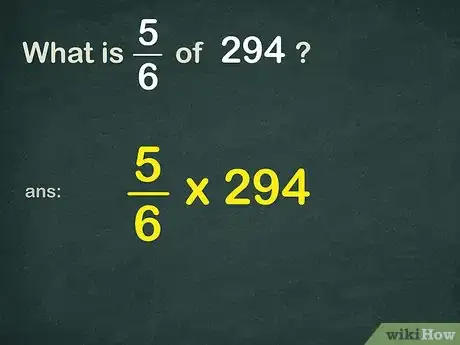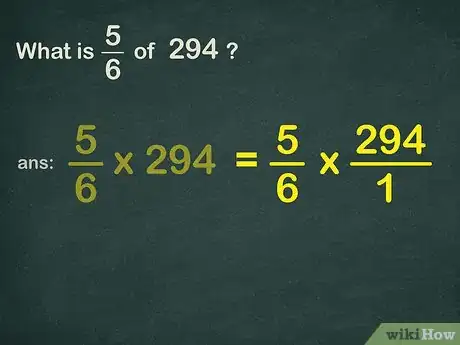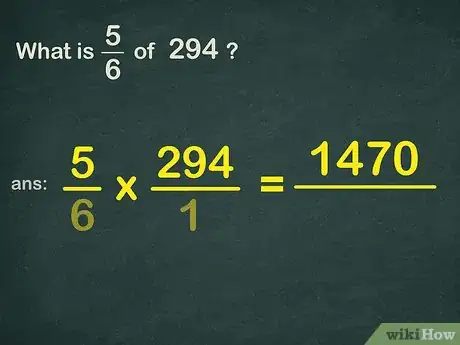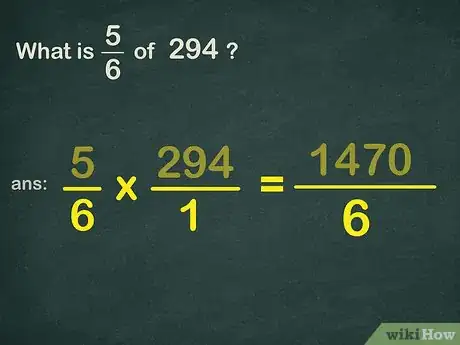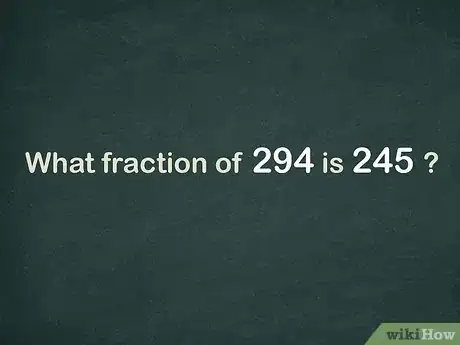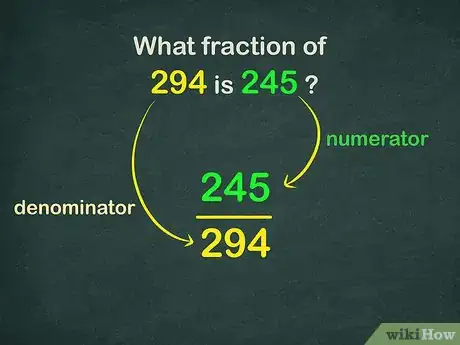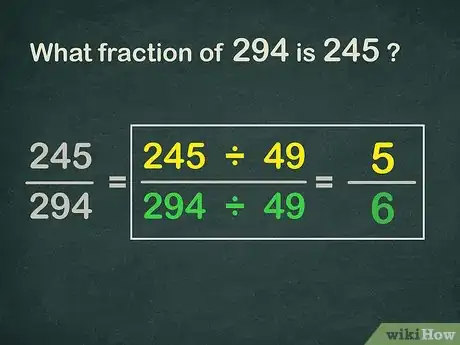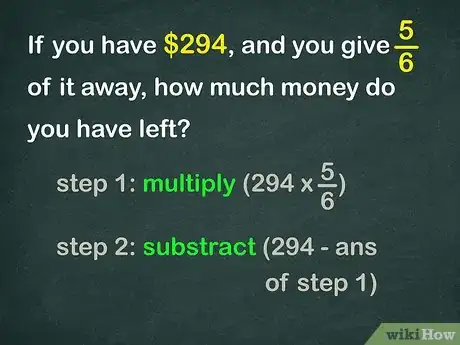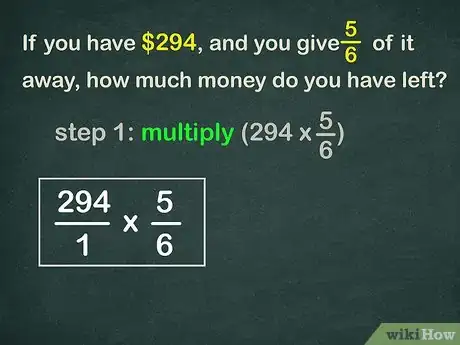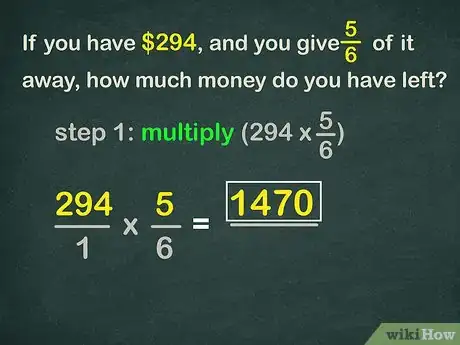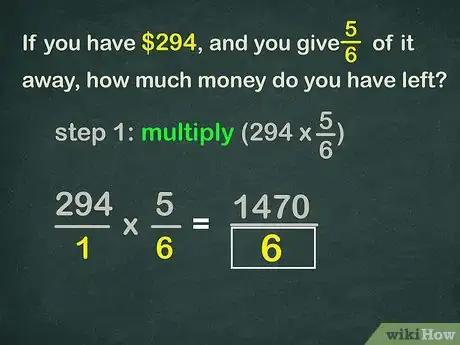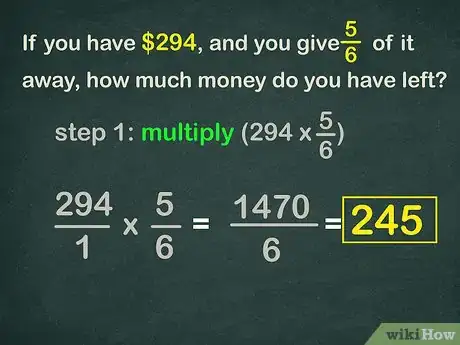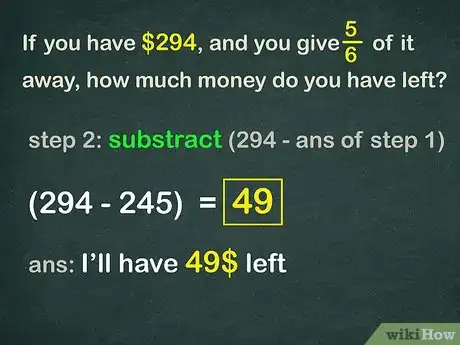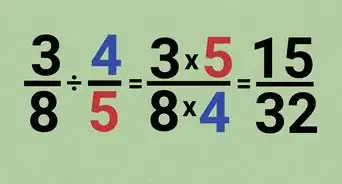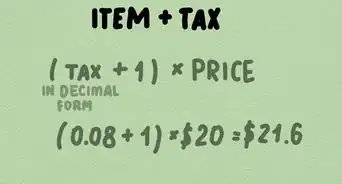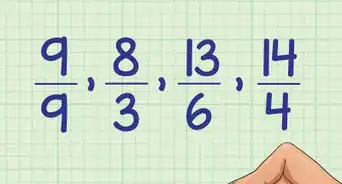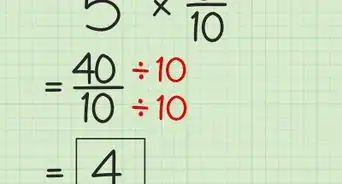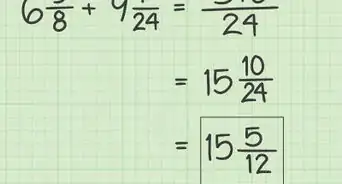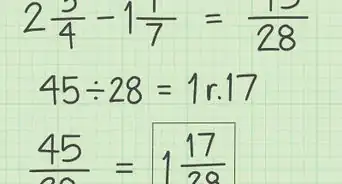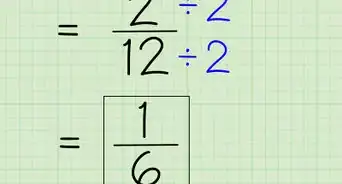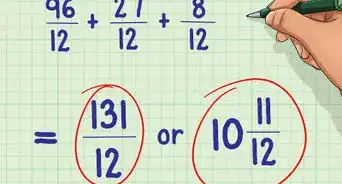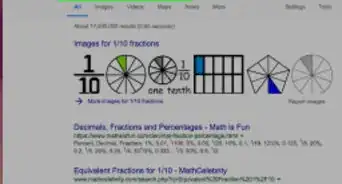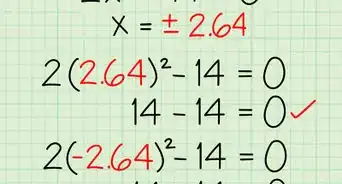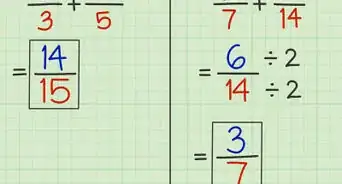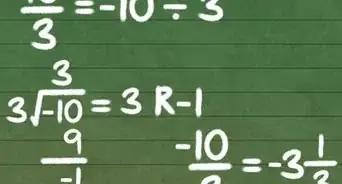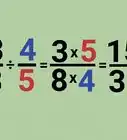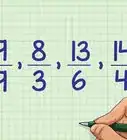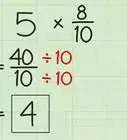This article was co-authored by wikiHow Staff. Our trained team of editors and researchers validate articles for accuracy and comprehensiveness. wikiHow's Content Management Team carefully monitors the work from our editorial staff to ensure that each article is backed by trusted research and meets our high quality standards.
This article has been viewed 178,909 times.
Learn more...
Finding a fraction of an amount is a useful skill you need for everyday, real-world math problems. For example, to find a discount price, or to determine a portion of something that you have (or a what portion you are missing), you need to know how to find the fraction of an amount. In these types of problems you will need to know how to multiply a fraction by a whole number, or how to create a fraction based on the information you are given. You might find that the most difficult part of these types of problems is determining what the problem is asking.
Steps
Calculating an Amount
-
1Set up the problem. When a problem asks you what a fraction of a whole number is, the problem is one of multiplication, and you need to multiply the fraction and the whole number. Look for the keyword of. When you see of in a word problem, you need to multiply.[1]
- For example, if the problem asks, “What is of ," you need to set up .
-
2Turn the whole number into a fraction. To do this, give it a denominator of 1. Remember, the denominator is the number underneath the fraction bar.[2]
- For example, you would change to . So the new problem becomes .
Advertisement -
3Multiply the numerators. Remember that the numerators are the numbers above the fraction bars.
- For example, .
-
4Multiply the denominators. Place this number under the product of the numerators.[3]
- For example, , so .
-
5Simplify the fraction. To do this, divide the numerator by the denominator. This will give you your final answer as a whole number or in decimal form. If the result is not a whole number and you need the answer written in the form of a fraction, you should reduce the fraction by dividing the numerator and denominator by their greatest common factor. For complete instructions on how to reduce a fraction, read Reduce Fractions.https://www.bbc.co.uk/bitesize/topics/zsxhfg8/articles/z33csrd
- For example, , so of .
Calculating a Fraction
-
1Understand what the problem is asking. When a problem asks you what fraction one whole number is of another whole number, you need to create a fraction and reduce it. Look for the key phrases “fraction of” or “out of.”[4]
- For example, if the problem asks, “What fraction of is ,” you need to create a fraction from the two given whole numbers.
-
2Determine the numerator and denominator. The numerator is the fraction of the whole. Often this will be the smaller number, but not always, so read the problem carefully. The denominator is the “complete” number. Look for the key phrase “fraction of .” The variable will be the denominator.
- For example, if the problem asks, “What fraction of is ,” you know that is the numerator, because this is the number that is a part, or fraction, of . So the fraction is .
-
3Simplify the fraction. To do this, find the greatest factor that is common to the numerator and the denominator, then divide each by that factor. For complete instructions on how to reduce fractions, read Reduce Fractions.
- For example, the greatest common factor of and is :
, so the reduced numerator is .
, so the reduced denominator is .
So, is of .
- For example, the greatest common factor of and is :
Changing an Amount By a Fraction
-
1Understand what the problem is asking. If the problem is asking you to determine how much of something is left, or to decrease an amount, or to find a discount, you will first multiply to find the fractional amount, then subtract the fractional amount from the original whole number. If the problem is asking you to determine how much of something there is after an increase, you will first multiply to find the fractional amount, then add the fractional amount to the original whole number.[5]
- For example, a problem might ask, “If you have , and you give of it away, how much money do you have left?” In this case, you will multiply, then subtract.
-
2Set up the multiplication problem. To do this, turn the whole number into a fraction by placing it over a denominator of .
- For example, to find , you would change the problem to .
-
3Multiply the numerators. This will give you your new numerator.
- For example, .
-
4Multiply the denominators. This will give you your new denominator. Rewrite the new fraction.[6]
- For example, . So the new fraction is .
-
5Simplify the fraction. First divide the numerator by the denominator to see if the result is a whole number. If the result is not a whole number, you should reduce the fraction by dividing the numerator and denominator by their greatest common factor. For complete instructions on how to reduce a fraction, read Reduce Fractions.
- For example, , so of . This is the fractional amount you are decreasing by.
-
6Change the original amount by adding or subtracting the fractional amount. This will give you your final answer.
- For example, . So, if you have , and you give of it away, you have left.
Community Q&A
-
QuestionHow much rope do I use if I have 9 1/4 meters of rope and use 2/7?
 Community AnswerThis problem is essentially asking, "What is 2/7 of 9 1/4?" So, you will multiply the two fractions to get your answer. For instructions on how to multiply two fractions, you can read the following article:http://www.wikihow.com/Multiply-Mixed-Numbers
Community AnswerThis problem is essentially asking, "What is 2/7 of 9 1/4?" So, you will multiply the two fractions to get your answer. For instructions on how to multiply two fractions, you can read the following article:http://www.wikihow.com/Multiply-Mixed-Numbers -
QuestionNine trucks are equal in weight to six trucks and four sedans. What fraction of the weight of a truck is the weight of a sedan?
 Community AnswerYou can set up the equation like this: 9x = 6x + 4y, where x = the weight of a truck, and y = the weight of a sedan. Since they want to know what fraction of a truck's weight (x) equals the weight of a sedan (y), you need to solve for y. 9x = 6x + 4y 3x = 4y 3/4x = y. So, the weight of a sedan is 3/4 the weight of a truck.
Community AnswerYou can set up the equation like this: 9x = 6x + 4y, where x = the weight of a truck, and y = the weight of a sedan. Since they want to know what fraction of a truck's weight (x) equals the weight of a sedan (y), you need to solve for y. 9x = 6x + 4y 3x = 4y 3/4x = y. So, the weight of a sedan is 3/4 the weight of a truck. -
QuestionWhat is 3 quarters of 40?
 Community Answer3 quarters is the same as 3/4. So this is a multiplication problem: 3/4 x 40 = 3/4 x 40/1 = 120/4 = 30
Community Answer3 quarters is the same as 3/4. So this is a multiplication problem: 3/4 x 40 = 3/4 x 40/1 = 120/4 = 30
References
- ↑ http://www.purplemath.com/modules/translat.htm
- ↑ https://sciencing.com/convert-fractions-whole-numbers-8570931.html
- ↑ https://www.bbc.co.uk/bitesize/topics/zt8dmp3/articles/zjtg47h
- ↑ http://www.purplemath.com/modules/translat.htm
- ↑ http://studymaths.co.uk/topics/findingAFractionOfAnAmount.php
- ↑ https://www.bbc.co.uk/bitesize/topics/zt8dmp3/articles/zjtg47h
About This Article
To work out a fraction of a whole number, turn the whole number into a fraction by giving it a denominator of 1. Next, multiply the numerators together and write down the answer. Then, multiply the denominators together and write that answer under the product of the numerators to create a new fraction. You can then simplify the fraction by dividing the numerator by the denominator to get your final answer! For tips on calculating a fraction, read on!
